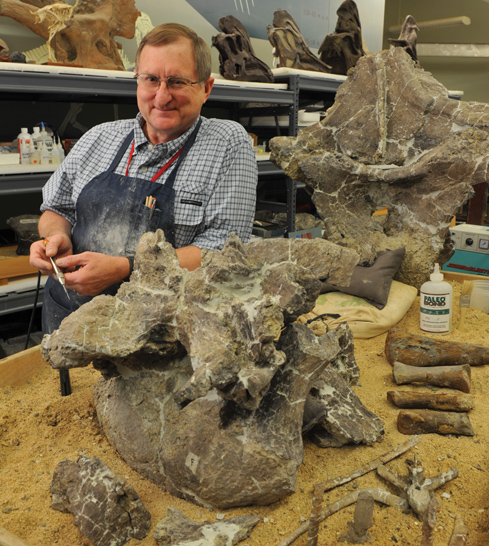 Summer 2012
Summer 2012|
Russ Christoforetti
For a month and a half solid, Russ Christoforetti has been chipping away sediment and meticulously piecing together a back vertebra of one of the largest land animals that has ever lived: a yet-to-be-identified, 100-foot-long, 40-ton-plus titanosaur—a type of long-necked, plant-eating sauropod dinosaur—from Argentina. Armed with an airscribe (a tiny jackhammer with a rotating tip) and glue, the retired anesthesiologist clocks up to 40 hours a week. But "don't dare call it a job and taint it," he warns. "This is a labor of love." Since the fall of 2009, the McMurray resident has logged nearly 3,000 volunteer hours—almost exclusively on the titanosaur—as a bone preparator in Carnegie Museum of Natural History's first-floor exhibit, PaleoLab. Christoforetti arrived as what he calls a "plug and play," meaning he was already trained at the University of Utah's fossil lab. More than two years later, it's tough to say who's gained more: the museum, or the man who first fell in love with the museum as a boy, and then again as a father of four and grandfather of eight, and now spends his days exactly as he wants—contributing to its world-class dinosaur legacy. The natural history buff with a sauropod-sized list of hobbies—from model trains and boat building to learning his family's native Italian with his Irish wife—next has his sights set on digging into what remains of the museum's 1909 jackpot from the Carnegie Quarry at what is now Utah's Dinosaur National Monument. PaleoLab is a unique part of the museum. Why?This isn't a diorama. Some people don't think that we're real, but this is where almost all of the large fossil bone preparation is done at the museum. One of the reasons I really love working here is that we're the only window into the functioning of the museum; you can watch the real deal happen here. Do you enjoy engaging visitors?When I see an engrossed group, scouts with their notebooks, a group wearing their dinosaur shirts, I'll go out and talk. I'll bring a rib out. It's from the titanosaur. They get to hold a piece of a dinosaur that doesn't even have a name yet. Children love it. The parents and teachers love it. To remove the public part of it would be a deal breaker for me. Have you always been interested in fossils?Yes, I've always been a geek. I got my first microscope when I was 6. We would go up into an abandoned mine where we weren't supposed to be to find plant fossils. We were roaming up in that cave when I was probably 8 or 9, and I've been hooked on fossils ever since. What appeals to you about bone preparation?I love building puzzles. None of this is repetitive. Each piece is a new piece. They're all different and when you open a [plaster] jacket, it's like Christmas morning, except you really don't know what's inside because it's nothing you asked for. It's just whatever you find and you deal with it. That's fun. Your grandkids must think you're the coolest?Yeah, they do. The oldest is 7. They come to the museums a couple times a month and I bring them into the lab and we let them hold a fossil. When any child comes by the lab, you don't know who's the next Matt Lamanna or Chris Beard [museum paleontologists] or chemist or doctor. Does your medical training help with your work?It does help to know anatomy. So if we think something is a vertebra, I have an idea of what it looks like. I can visualize it in the rock. The names are a little different from humans to dinosaurs, but they have ribs, they have bones, just like specimens in any comparative anatomy course. Why is opening the few remaining plaster jackets from Dinosaur National Monument such a rush?I went to Penn State and there, it's "We are Penn State." Well, we are The Carnegie for crying out loud! We were in on the dinosaur wars. How many museums in the world can say we're going to open a jacket from the great dinosaur hunters from the 1900s that started all of this? Even if we do think we know what's there, I'll be the first to see these bones in 100 years. I'm like a kid in a candy store. Is it safe to say you've found your passion?You can't have institutions like this without generation after generation catching the fire. I'm thrilled to play a role in that. My father said there was never a day he regretted going to work. There's never a day I regret coming in here. It only took me 30 years to find a position like that, but better late than never.
|
First Impressions · GUITAR · Manufacturing Ideas · Growing Up a Science Rock Star · Special Section: A Tribute to Our Donors · Director's Note · NewsWorthy · Artistic License: The Power of the Painter · Field Trip: Appalachian Wonder · Science & Nature: Taste the Rainbow · The Big Picture
 |
Copyright © 2017 CARNEGIE Magazine. All rights reserved. |

